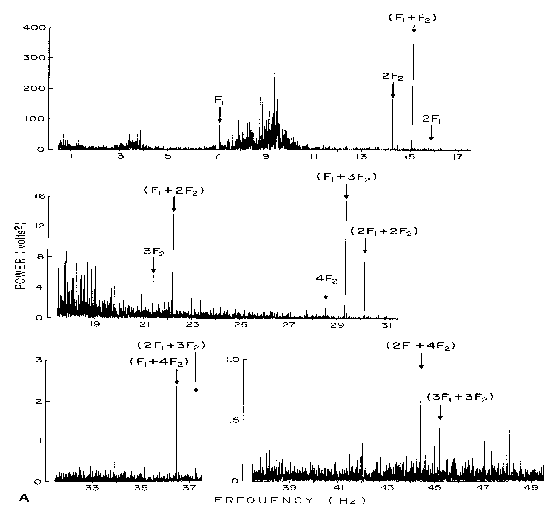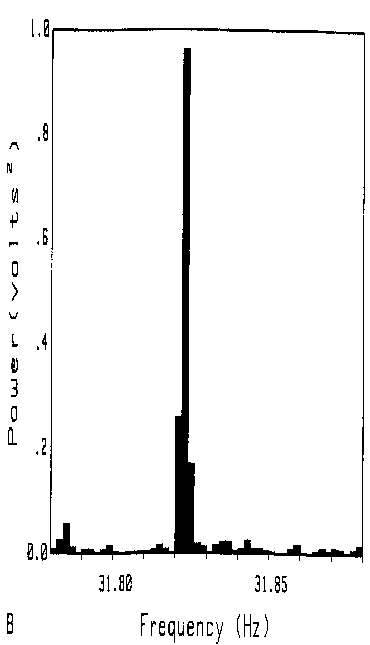
Resonance-like behavior measured in brain.
David
Regan, F.R.S.C, of York University and the University of Toronto, has measured
brain magnetic fields (MEG) and scalp voltages (EEG) during evoked stimulation.
Figs 9 and 10(1) show some of Regan's measurements
using his zoom FFT technique. The behavior shown is typical
of that measured, magnetically or electrically, in response to many kinds
of evoked stimuli.

Fig. 9
The caption for this figure reads:
"The stimulus was a homogeneous patch of light flickering
at F1 superimposed on a second patch flickering at F2.
The EEG was analyzed by nondestructive zoom FFT at resolution of 0.0039
Hz. Recording duration was 320 seconds. The section contains 12,000 lines
over a bandwidth of .5 - 49.5 Hz. The steady-state evoked potential consists
of discrete frequency components whose bandwidths are less than 0.0039
Hz. . . . " The data have characteristics often seen in resonant systems
with very low damping, with sums and integer multiples of the stimulus."
Figure 10 shows evidence of bandwidths narrower than bin
widths of .0019 Hz. The 4F component is
shown. Bandwidths of the peaks measured in Fig 9 may have been
no wider than this.

Fig. 10
These sharp, high information
content patterns, with stimuli frequency multiples organized roughly as
shown, show that brain includes sharply resonant components, and shows
that these components are coupled with very small lags and with small damping.
The bandwidths Regan measures are too sharp by at least an
order of magnitude to be produced by membrane channel activity.
The pyramidal cells in brain,
interpreted according to the S-K theory, should behave in a manner that
generates the kind of behavior that Regan measured. Conduction
lines (in one of the two predicted modes) have very low distortion.
Effective line inductances are far greater than those predicted by Kelvin-Rall
- high enough so that neurons can be inductively coupled via the intercellular
medium, which conducts millions of time faster than line conduction speed.
The dendritic spines have the sharply resonant requirements Regan's data
appears to require.
Robert
Showalter
showalte@macc.wisc.edu
1. Regan, David HUMAN BRAIN ELECTROPHYSIOLOGY: Evoked Potentials and Evoked Magnetic Fields in Science and Medicine Elsevior, 1989, Fig 1.70A and Fig 1.70B, pp 106-107.